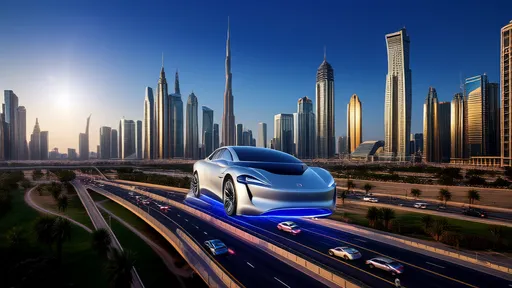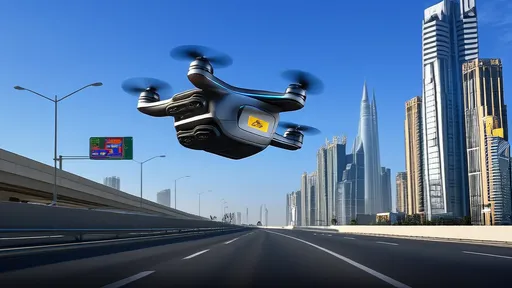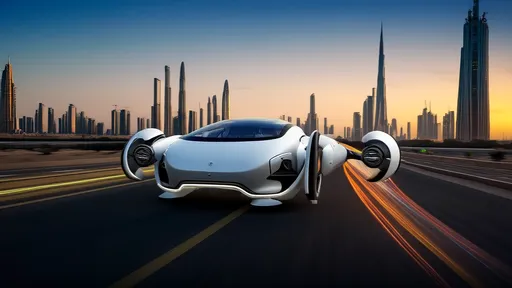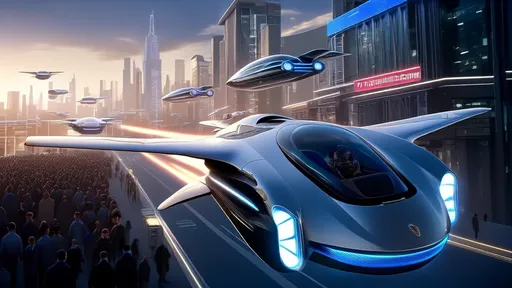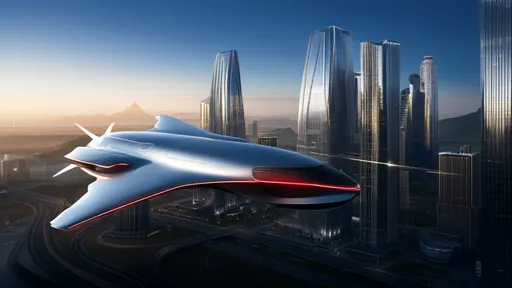In the shimmering heat of the Arabian Gulf, a new silhouette is beginning to pierce the horizon. It is not the familiar form of a commercial airliner nor the sleek profile of a private jet, but something altogether more futuristic—a flying car. This vision, once confined to the realms of science fiction, is fast becoming a tangible reality, and it is Chinese innovation that is poised to turn the skies above Dubai, Abu Dhabi, and Riyadh into a dazzling new theater of urban mobility.
The Gulf region, with its audacious architectural marvels and relentless pursuit of the next technological frontier, has long been a natural habitat for the extraordinary. Now, it is setting the stage for the next great leap: the integration of flying cars into its urban fabric. Chinese companies, having poured billions into research and development, are emerging as the unlikely but formidable protagonists in this aerial drama. They are not just selling vehicles; they are offering a complete reimagining of transportation, and the oil-rich sheikhdoms are listening with keen interest.
The strategic courtship between Chinese eVTOL (electric Vertical Take-Off and Landing) manufacturers and Gulf sovereign wealth funds is a masterclass in symbiotic ambition. For China, it is a gateway to global legitimacy and a testbed in an environment that encourages, rather than restricts, bold technological experimentation. The Gulf nations, in their relentless drive to diversify beyond hydrocarbons, see this as a cornerstone of their futuristic city-blueprints. It is a partnership forged not just in boardrooms, but in a shared vision of a tomorrow that has already arrived.
At the forefront is a company like EHang, whose autonomous passenger-grade drones have already conducted demonstration flights over the iconic Dubai Marina. The sight of its sleek, multi-rotor craft humming silently above the glittering skyscrapers was more than a publicity stunt; it was a statement of intent. Other Chinese giants, from Geely’s Terrafugia to Xpeng’s AeroHT, are hot on its heels, showcasing prototypes that range from roadable aircraft to sleek, futuristic pods designed exclusively for the air. They bring to the table a formidable combination of advanced battery technology, sophisticated autonomous flight systems, and, crucially, a manufacturing scale that can potentially bring costs down to earth.
The allure for Gulf cities is multifaceted, addressing some of their most pressing urban challenges. The legendary traffic congestion of metropolises like Dubai, which costs the economy billions annually, could be alleviated by taking a significant portion of travel into the third dimension. Imagine a high-net-worth executive bypassing the Sheikh Zayed Road gridlock, whisking from a rooftop in Downtown Dubai to a meeting at the Abu Dhabi Global Market in a fraction of the time. This is the promise being sold—not just convenience, but the reclamation of time itself.
Furthermore, the flying car ecosystem aligns perfectly with the Gulf's vision for a tech-centric, sustainable future. These eVTOLs are electric, producing zero operational emissions—a key selling point for nations like the UAE and Saudi Arabia, which have committed to ambitious net-zero targets. The integration of this new mode of transport also complements massive ongoing investments in smart city infrastructure, where data, connectivity, and automation converge. A network of "vertiports" on skyscraper rooftops could become as common as metro stations, seamlessly connected to the digital fabric of the city.
However, the path to this airborne utopia is strewn with formidable challenges, and the Gulf's role as an early adopter is as much about solving these problems as it is about embracing the technology. The most significant hurdle is regulation. Creating a entirely new air traffic management system for low-altitude urban airspace is a monumental task. It requires drafting new safety certifications, pilot (or remote operator) licensing frameworks, and intricate protocols to prevent mid-air collisions. The General Civil Aviation Authority (GCAA) in the UAE is already deep in this process, working with international bodies and the manufacturers themselves to build a regulatory scaffold that is both safe and permissive enough to allow the industry to flourish.
Public acceptance is another critical battlefield. The persistent whir of rotors and the perceived safety risks of flying vehicles could spark public resistance. Chinese companies are acutely aware of this and are investing heavily in noise-reduction technology and building a near-perfect safety record through rigorous testing. The narrative they, and their Gulf partners, must craft is one of unparalleled safety and quiet efficiency, transforming public anxiety into awe and acceptance.
Economically, the implications are profound. The nascent flying car industry promises to spawn entirely new sectors—from vertiport construction and management to remote fleet operations, maintenance, and software development. For the Gulf, this represents another strategic step in cultivating a post-oil knowledge economy. By partnering with Chinese firms, they are not merely importing a product; they are gaining access to the intellectual property and R&D prowess that could allow them to eventually localize aspects of production and operation, creating high-skilled jobs for their citizens.
The geopolitical dimension of this partnership cannot be overlooked. In an era of shifting global alliances, the deepening technological cooperation between China and the Arab Gulf states signals a pragmatic realignment. It is a relationship built on tangible economic and technological exchange, with the flying car sector serving as a highly visible symbol of this new Silk Road in the sky. While Western competitors like Joby Aviation and Archer Aviation continue to develop their own impressive technologies, the first-mover advantage in the commercially and symbolically potent Gulf market appears, for now, to be leaning decisively towards the East.
As the sun sets over the Persian Gulf, casting a golden glow on its futuristic cityscapes, the stage is set. The drones and flying cars from China are no longer just prototypes in a hangar; they are the vanguard of an urban revolution. The skies, long the domain of aircraft passing high overhead, are about to become a new, dynamic layer of city life. In this grand experiment, the world will be watching. The success or failure of this ambitious fusion of Chinese technology and Gulf ambition will not only determine the morning commute for a privileged few in Dubai but will likely chart the course for the future of urban mobility for cities across the globe. The great Gulf air show is about to begin, and its star performers are arriving from the East.
The once-fantastical vision of humanoid robots, long confined to the pages of science fiction and the silver screen, is steadily materializing into a tangible engineering reality. This evolution is not the result of a single, monumental breakthrough but rather a profound and intricate symphony of advancements across a multitude of scientific and engineering disciplines. The quest to create machines that not only look but also move, perceive, and interact with the fluidity and adaptability of humans represents one of the most ambitious technological endeavors of our time. It is a grand convergence, where progress in artificial intelligence, materials science, mechanical engineering, and cognitive science coalesces to breathe life into metal and silicon, pushing the boundaries of biomimicry to unprecedented heights.
The recent inclusion of humanoid robots in the 2025 Top Ten Global Engineering Achievements marks a watershed moment in technological history. This recognition transcends mere academic acknowledgment; it represents a collective global validation of decades of research, development, and iterative innovation in robotics. For years, humanoid robots existed primarily in the realms of science fiction and laboratory prototypes, often viewed as fascinating but distant curiosities. Their elevation to a top global engineering feat signals a profound shift—a transition from conceptual marvels to tangible agents of change poised to reshape our societal and industrial landscapes.
In a landmark recognition of human engineering prowess, China's full-ocean-depth manned submersible has been selected among the 2025 Top Ten Global Engineering Achievements, standing shoulder-to-shoulder with revolutionary projects like quantum computing infrastructure and Mars colonization prototypes. This prestigious listing, announced by the International Engineering Consortium earlier this morning, represents more than just technological acknowledgment—it signifies humanity's renewed commitment to conquering Earth's final frontier.
In the heart of Dubai's morning rush hour, the familiar gridlock of Sheikh Zayed Road stretches for kilometers below, but above the shimmering asphalt, a new dimension of transportation is quietly rewriting the rules of urban mobility. As first reported by The Times of India, the city's ambitious flying car initiative has transitioned from futuristic concept to operational reality, with commuters now gliding between skyscrapers in electric vertical take-off and landing vehicles. This isn't a scene from a science fiction film but the new daily reality for a growing number of Dubai residents who have traded their terrestrial commutes for the freedom of three-dimensional travel.
The desert skies of the United Arab Emirates, long dominated by the sleek silhouettes of commercial airliners and private jets, are poised to welcome a new kind of vessel. In a landmark decision that signals a significant leap from science fiction to tangible reality, a specific model of flying car has been granted a special certificate of flight from the UAE's civil aviation authority. This is not merely a provisional test permit for a closed course; it is a crucial regulatory nod that brings the vision of urban air mobility one giant step closer to the daily lives of the region's residents.
In a move signaling a new era of technological collaboration, Southeast Asian nations and the United States are forging a groundbreaking partnership in artificial intelligence development. This strategic alliance emerges at a critical juncture when global AI governance remains fragmented and the technology's potential to reshape economies and societies becomes increasingly apparent. The collaboration represents more than just technical cooperation—it embodies a shared vision for responsible innovation that respects cultural diversity while addressing common challenges.
The Euclid Space Telescope, humanity's newest and most ambitious eye on the cosmos, has begun its monumental mission to pierce the profound darkness that envelops our universe. Launched into the silence beyond our atmosphere, its purpose is not merely to capture stunning celestial portraits but to map the invisible architecture of reality itself. For decades, astronomers have known that the cosmos we see—the glittering tapestry of stars, galaxies, and nebulae—comprises a mere five percent of the total content of the universe. The remaining ninety-five percent is a profound mystery, a dual enigma composed of dark matter and dark energy. These are the phantoms of physics, entities that do not emit, absorb, or reflect light, yet whose gravitational influence dictates the fate of everything we hold visible. Euclid is our most sophisticated attempt to date to bring these shadows into the light, to understand the hidden forces that have shaped the universe's past and will determine its ultimate destiny.
Beijing's National Stadium, once the iconic centerpiece of the 2008 Summer Olympics, echoed with a different kind of applause this week. The thunderous cheers were not for human athletes pushing the limits of physical endurance, but for their mechanical counterparts—humanoid robots competing in the inaugural World Humanoid Robot Sports Games. The air, thick with the whirring of servos and the collective anticipation of engineers and spectators, marked a pivotal moment in the history of robotics and international sport.
The landscape of oncology treatment is undergoing a profound transformation, driven by the emergence of third-generation antibody-drug conjugates (ADCs). These sophisticated therapeutic agents represent a significant leap forward in the quest for precision medicine, offering new hope for patients battling various forms of cancer. Unlike conventional chemotherapy that attacks both healthy and cancerous cells indiscriminately, these advanced biologics deliver potent cytotoxic agents directly to tumor cells, minimizing damage to healthy tissues and reducing debilitating side effects.
In the relentless battle against cancer, a revolutionary class of therapeutics has emerged, earning the evocative moniker of "precision missiles" for their ability to deliver potent cytotoxic agents directly to malignant cells while sparing healthy tissue. These are Antibody-Drug Conjugates, or ADCs, and they represent a sophisticated fusion of biologic targeting and potent chemotherapy, a paradigm shift in oncology that is redefining treatment expectations for a growing number of cancers.
The desert skies above Dubai witnessed a historic moment last week as the sleek silhouette of a flying car cut through the cerulean blue, marking what many industry experts are calling the dawn of a new era in personal transportation. The demonstration, orchestrated by the pioneering aviation firm AeroMobil Emirates, was not merely a test flight; it was a powerful statement of intent, a tangible promise of a future once confined to the pages of science fiction.
In a remarkable demonstration of growing consumer confidence in aerial mobility solutions, global pre-orders for flying cars have surged past the 7,000-unit milestone. This significant threshold, reached far earlier than most industry analysts had projected, signals a fundamental shift in public perception about the viability of personal air transportation. What was once confined to science fiction novels and futuristic concept videos is rapidly transforming into a tangible consumer product category with demonstrated market demand.
In the shimmering heat of the Arabian Gulf, a new silhouette is beginning to pierce the horizon. It is not the familiar form of a commercial airliner nor the sleek profile of a private jet, but something altogether more futuristic—a flying car. This vision, once confined to the realms of science fiction, is fast becoming a tangible reality, and it is Chinese innovation that is poised to turn the skies above Dubai, Abu Dhabi, and Riyadh into a dazzling new theater of urban mobility.
The relentless march of artificial intelligence demands computational power on a scale previously unimaginable. At the heart of this revolution lies the Graphics Processing Unit, or GPU, which has evolved from a specialized graphics rendering component into the primary engine for AI workloads. The latest generation of GPU architectures represents a paradigm shift, not merely an incremental improvement. These new designs are fundamentally re-engineering the silicon to tackle the unique and colossal demands of modern AI, with a core focus on achieving unprecedented levels of computational density and efficiency through hyper-scale integration.
The ASEAN-US AI Cooperation Forum concluded its third annual session this week with a renewed commitment to bridging the digital divide through focused capacity building and infrastructure development. Held against the backdrop of rapid technological advancement, the forum brought together policymakers, industry leaders, and academics to chart a collaborative path forward, recognizing that the benefits of artificial intelligence must be distributed equitably to ensure regional stability and prosperity.



